|
|
 |
|
Calanoida ( Order ) |
|
|
|
Clausocalanoidea ( Superfamily ) |
|
|
|
Aetideidae ( Family ) |
|
|
|
Paracomantenna ( Genus ) |
|
|
| |
Paracomantenna minor (Farran, 1905) (F,M) | |
| | | | | | | Syn.: | Bryaxis minor Farran, 1905 (p.32, Descr.F, figs.F); Pearson, 1906 (p.12); Rose, 1933 a (p.102, figs.F); Vervoort, 1952 b (n°43, p.3, figs.F). | | | | Ref.: | | | Campaner, 1978 (p.876, Rem.); Bradford & Jillett, 1980 (p.63); Alvarez, 1986 (p.858, 875); Markhaseva, 1996 (p.238, figs.F); Markhaseva & Renz, 2019 (p.213, p.215: Table 1, p.223: Rem.: male). |  issued from : G.P. Farran in Ann. Rep. Fish. Brch., Ireland, 1902-1903, II, App. 2, 1905. [Plate IV, Figs.1-12]. As Bryaxis minor. Female (from W Ireland): 1-2, habitus (lateral and dorsal, respectively); 4, A2; 5, exopod of A2; 7, Mx1; 8, Mx2; 9, Mxp; 10-12, P1 to P3.
|
 issued from : G.P. Farran in Ann. Rep. Fish. Brch., Ireland, 1902-1903, II, App. 2, 1905. [Plate IV, Figs.3]. As Bryaxis minorFemale: 3, A1.
|
 issued from : M.P.J. Alvarez in J. Crustacean Biol., 1986, 614. [p.874, Figs.91-93]. After Farran (1905). Female: 91, A2; 92, Mx2; 93, Mxp.
|
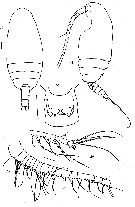 issued from : E.L. Markhaseva & S.B. Schnack-Schiel in Ophelia, 2003, 57 (2). [p.113, Figs.22-26]. Female (from 29°-30°N, 28°-28°30'W): 22-23, habitus (dorsal and left lateral, respectively); 24, genital segment (ventral); 25, A1 (segments 1-17); 26, A1 (segments 17-24). Scale bars: 0.1 mm. Nota : Prosome-urosome ratio : 3.9. Cephalosome and 1st pedigerous somite fused, 4th and 5th incompletely fused (suture is visible in lateral view). Rostrum absent. A1 24-segmented. Spermathecae elongate and curve anteriorly. Posterior corners of 5th pedigerous somite pointed and curved dorsally Caudal rami with 4 terminal, 1 ventral and 1 short lateral setae.
|
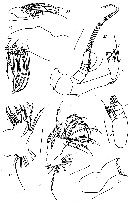 issued from : E.L. Markhaseva & S.B. Schnack-Schiel in Ophelia, 2003, 57 (2). [p.114, Figs.27-33]. Female: 27, A2; 28, Md (mandibular palp); 29, Md (gnathobase); 30, 1st and 2 nd basal endites, endopod and exopod of Mx1; 31, praecoxal arthrite, coxal endite and coxal epipodite of Mx1; 32, praecoxal and coxal endites of Mx2; 33, basal endite plus exopod of Mx2. Scale bars: 0.1 mm. Nota : Coxa of A2 with a small seta ; basis with 2 setae ; 1st segment of exopod without seta, segments 2-6 with 1 seta each, segment 7 with 3 terminal setae ; endopodal segment 1 with 2 setae distally, segment 2 with 5 plus 5 setae. Mandibular palp basis with 1 small seta ; 1st endopodal segment with 1 seta, 2nd segment with 4 terminal setae ; cutting edge of gnathobase with 5 teeth and 1 articulated seta. Mx1 praecoxal arthrite with 9 terminal, 4 posterior and 1 anterior setae ; coxal endite with 4 setae ; 1st and 2 nd basal endites with 3 setae each ; endopod with 12 setae ; exopod with 11 seta ; coxal epipodite with 5 large, 2 medium-sized and 2 tiny setae. Mx2 praecoxal and proximal coxal endites with 1 seta and 2 strongly sclerotized spine-like setae ; praecoxal and coxal endites with surface robust short spines ; basal endite with a strong spine supplied with large teeth and 2 setae ; exopod with 6 setae.
|
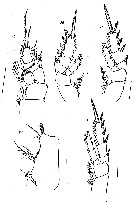 issued from : E.L. Markhaseva & S.B. Schnack-Schiel in Ophelia, 2003, 57 (2). [p.115, Figs.35-38]. Female: 34, Mxp (syncoxa); 35-38, P1 to P4. Scale bars: 0.1 mm. Nota : Mxp syncoxa with 1 seta on proximal lobe, 2 setae on middle lobe, 3 setae on distal lobe and coxal lobe with a group of 3 setae plus a digitiform sensory appendage ; basis with 3 setae in proximal half of the segment and 2 setae distally ; endopod 5-segmented with 4, 4, 4, 3 + 1 and 4 setae, respectively.
|
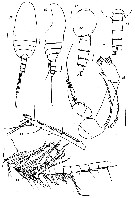 issued from : E.L. Markhaseva & S.B. Schnack-Schiel in Ophelia, 2003, 57 (2). [p.117, Figs.39-46]. Male: 39-40, habitus (dorsal and left lateral, respectively); 41, forehead (ventral view); 42-43, prosomal posterior corners (left lateral and dorsal, respectively); 44, A1 (segments 1-17); 45, A1 (segments18-23); 46, A2. Scale bars: 0.1 mm. Nota : Rostrum absent. A1 23-segmented, reaching4th-5th pedigerous somite. Prosome :urosome ratio 3.0-3.2. Cephalosome and 1st pedigerous somite fused, 4th and 5th incompletely separated. Caudal rami with 4 large terminal, 1 small lateral and 1 ventral setae. Coxa of A2 with a setal element (broken) ; basis with 2 strong setae ; endopod enlarged compared with that of the female ; exopod 6-indistinctly segmented (2nd and 3rd segments articuled in females are fused in males) , 1st segment without seta, 2nd with 2 setae, 3rd to 5th with 1 seta each, 6th segment with 3 terminal setae ; 1st endopodal segment with 1 seta distally, 2nd segment with 4 plus 6 setae.
|
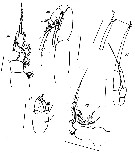 issued from : E.L. Markhaseva & S.B. Schnack-Schiel in Ophelia, 2003, 57 (2). [p.118, Figs.47-51]. Male: 47, Md (mandibular palp); 48, Mx1; 49, Mxp; 50, P1; 51, P5. Scale bars: 0.1 mm. Nota : Mandibular gnathobase is very reduced. Mx1 very reduced, only endopod and exopod bear setae ; endopod with wit 5 small setae ; exopod with 10 setae.Mx2 very reduced to a small lobe lacking setae. Mxp syncoxa without setae ; basis with 1 seta at about middle length and 1 distal seta ; endopod 5-segmented with 3, 3, 2, 2 + 1, and 4 setae. P1 endopod outer lobe less well developed compared with the female. Left P5 5-segmented, distal segment elongate, its proximal (basal) part is lobe-like with terminal hairs and distal part is covered with hairs along its border ; right P5 4-segmented, distal segment elongate and spine-like terminally. Rem : Mxp syncoxa with digitiform appendage on coxal lobe for the stage V (as in adult female ; endopod 5-segmented with 3, 3, 2, 2 + 1, and 4 setae, respectively.
|
 Paracomantenna minor Paracomantenna minor female: 1 - Distal part of Mxp protopodite without tube-like.
|
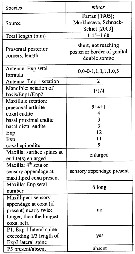 Issued from : E.L. Markhaseva & J. Renz in Arthropoda Selecta, 2019, 28 (2). [p.215, Table 1]. Selected morphological characters of P. minor female. Compare with others Paracomantenna species female.
| | | | | Compl. Ref.: | | | Holmes, 2001 (p.50); Bradford-Grieve, 2004 (p.284). | | | | NZ: | 1 | | |
|
Distribution map of Paracomantenna minor by geographical zones
|
| | | | Loc: | | | off W Ireland, off Canary Is. (Great Meteor Seamount: 29-30°N, 28-29°W).
Type locality: 53°58'N, 12°28'W. | | | | N: | 4 | | | | Lg.: | | | (58) F: 1,6; (890) F: 1,45-1,6 ; M: 1,2-1,25; {F: 1,45-1,60; M: 1,20-1,25} | | | | Rem.: | hyperbenthic (300-537 m).
Björnberg & al. (1981, p.605) report this species from the SW Atlantic, which is not cited anymore in their identification key (I have not been able to find other references of this species in this region (CR)).
According to Markhaseva & Schnack-Schiel (2003,p.119), the well developed sensory appendage of P. minor on the coxal lobe of Mxp syncoxa is a derived character unique within Clausocalanoidea (as well as for Calanoida in general). It is found in the family Aetideidae only in some benthopelagic genera: Bradyetes, Comantenna, Crassantenna, Mesocomantenna, Paracomantenna and Pseudeuchaeta.
For Markhaseva & Schnack-Schiel (2003, p.116) the sensory appendage in the distal part of syncoxa of Mxp (coxal lobe) in Paracomantenna females and CV males is a key character, an dis another example of the presence of sensory elements on the maxilliped syncoxa in the superfamily Clausocalanoidea to which the Aetideidae belongs. Clausocalanoidean families Diaixidae, Parkiidae, Phaennidae, Scolecitrichidae, and Tharybidae possess sensory elements on Mx2 and Mxp syncoxa. Their sensory elements originate from the transformation of sclerotized seta into a sensory seta (Nishida & Ohtsuka, 1997). On the Mxp they are usually situated (if present) on praecoxal lobes of the syncoxa (proximal, middle, or distal) but never on the coxal lobe (the distal lobe of segment). In aetideid genera Bradyetes, Comantenna, Mesocomantenna, Paracomantenna and Pseudeuchaeta have a sensory element on the Mxp syncoxa associated with the coxal lobe near a group of 3 sclerotized setae, which (i.e., 3 sclerotized setae here) is typical of clausocalanoideans. The senssory element in aetideids is not a transformed sclerotized seta, but the poorly sclerorized attenuation of the maxillipedal coxal lobe edge, digitiform in shape. Thus we observe the evolutionary independant origination of sensory structures in clausocalanoideans that may function as chemoreceptors in the detection of food (Nishida & Ohtsuka, 1997 ; Ohtsuka & al., 1998).. | | | Last update : 14/02/2020 | |
|
|
 Any use of this site for a publication will be mentioned with the following reference : Any use of this site for a publication will be mentioned with the following reference :
Razouls C., Desreumaux N., Kouwenberg J. and de Bovée F., 2005-2025. - Biodiversity of Marine Planktonic Copepods (morphology, geographical distribution and biological data). Sorbonne University, CNRS. Available at http://copepodes.obs-banyuls.fr/en [Accessed December 24, 2025] © copyright 2005-2025 Sorbonne University, CNRS
|
|
 |
 |











